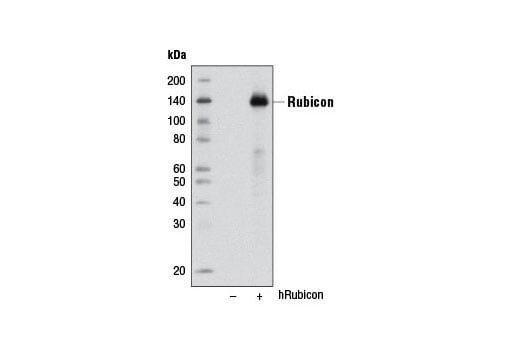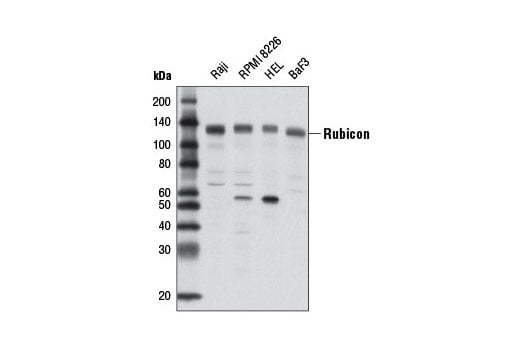 全部商品分类
全部商品分类


1/2
产品介绍
产品介绍
产品信息
荧光素标记
抗原名称
Rubicon

来源纯化
Monoclonal antibody is produced by immunizing animals with a synthetic peptide corresponding to residues surrounding Leu210 of human Rubicon protein.

宿主
Rabbit

商品描述
Product Usage Information
| Application | Dilution |
|---|---|
| Western Blotting | 1:1000 |

同种型
Rabbit IgG

分子量
130

研究领域
癌症,细胞生物学,纤维化,代谢,神经科学

应用
反应种属
Human,Mouse,

目标/特异性
Specificity/Sensitivity
Rubicon (D9F7) Rabbit mAb recognizes endogenous levels of total Rubicon protein. A band of unknown origin is detected at 55 kDa.
Species Reactivity:
Human, Mouse

敏感性
Endogenous

背景
背景
Autophagy is a catabolic process for the autophagosomic-lysosomal degradation of bulk cytoplasmic contents (1,2). Autophagy is generally activated by conditions of nutrient deprivation but is also associated with a number of physiological processes, including development, differentiation, neurodegeneration, infection, and cancer (3). The molecular machinery of autophagy was largely discovered in yeast and is directed by a number of autophagy-related (Atg) genes. These proteins are involved in the formation of autophagosomes, which are cytoplasmic vacuoles that are delivered to lysosomes for degradation. The class III type phosphoinositide 3-kinase (PI3K) Vps34 regulates vacuolar trafficking and autophagy (4,5). Multiple proteins associate with Vps34, including p105/Vps15, Beclin-1, UVRAG, Atg14, and Rubicon (6-12). Atg14 and Rubicon were identified based on their ability to bind to Beclin-1 and participate in unique complexes with opposing functions (9-12). Rubicon, which localizes to the endosome and lysosome, inhibits Vps34 lipid kinase activity; knockdown of Rubicon enhances autophagy and endocytic trafficking (11,12). In contrast, Atg14 localizes to autophagosomes, isolation membranes, and ER and can enhance Vps34 activity. Knockdown of Atg14 inhibits starvation-induced autophagy (11,12).
1.Reggiori, F. and Klionsky, D.J. (2002) Eukaryot Cell 1, 11-21.
2.Codogno, P. and Meijer, A.J. (2005) Cell Death Differ 12 Suppl 2, 1509-18.
3.Levine, B. and Yuan, J. (2005) J Clin Invest 115, 2679-88.
4.Corvera, S. (2001) Traffic 2, 859-66.
5.Yan, Y. and Backer, J.M. (2007) Biochem Soc Trans 35, 239-41.
6.Stack, J.H. et al. (1995) J Cell Biol 129, 321-34.
7.Zeng, X. et al. (2006) J Cell Sci 119, 259-70.
8.Liang, C. et al. (2006) Nat Cell Biol 8, 688-99.
9.Itakura, E. et al. (2008) Mol Biol Cell 19, 5360-72.
10.Sun, Q. et al. (2008) Proc Natl Acad Sci USA 105, 19211-6.
11.Zhong, Y. et al. (2009) Nat Cell Biol 11, 468-76.
12.Matsunaga, K. et al. (2009) Nat Cell Biol 11, 385-96.

研究领域
癌症,细胞生物学,纤维化,代谢,神经科学
翻译后修饰
unmodified

制备和贮存
保存方式
Supplied in 10 mM sodium HEPES (pH 7.5), 150 mM NaCl, 100 µg/ml BSA, 50% glycerol and less than 0.02% sodium azide. Store at –20°C. Do not aliquot the antibody.
数据库链接
Entrez-Gene ID
9711

UniProt ID
Q92622

参考图片
Western blot analysis of extracts from 293T cells, mock transfected (-) or transfected with human Rubicon (hRubicon, +), using Rubicon (D9F7) Rabbit mAb. Rubicon construct was kindly provided by Dr. Qing Zhong, University of California, Berkeley, CA.
Western blot analysis of extracts from various cell lines using Rubicon (D9F7) Rabbit mAb.
声明 :本官网所有报价均为常温或者蓝冰运输价格,如有产品需要干冰运输,需另外加收干冰运输费。






 用小程序,查商品更便捷
用小程序,查商品更便捷




